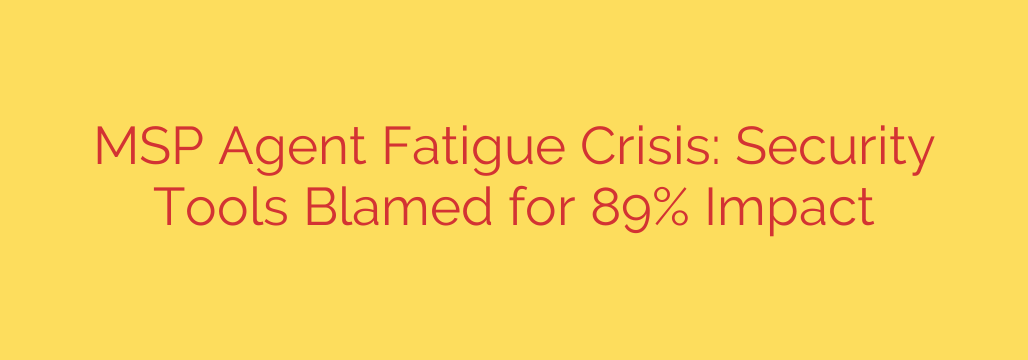
The Hidden Crisis of MSP Agent Fatigue: Why Your Security Stack is Burning Out Your Team
The alerts never stop. For technicians at Managed Service Providers (MSPs), this is the daily reality. A constant stream of notifications from dozens of different security tools creates a high-stress environment where critical threats can easily get lost in the noise. This isn’t just a minor inconvenience; it’s a full-blown crisis known as MSP agent fatigue, and it’s putting both your team and your clients at serious risk.
The core of the problem is a paradox: the very tools intended to enhance security are becoming the biggest source of operational friction and human error. As the cybersecurity landscape grows more complex, MSPs have layered on solution after solution—Endpoint Detection and Response (EDR), Security Information and Event Management (SIEM), firewalls, email security, and more. While each tool serves a purpose, their lack of integration creates a management nightmare.
Recent industry findings highlight the severity of this issue, showing that a staggering 89% of MSPs report that the sheer number of security tools directly impacts their team’s effectiveness and ability to manage alerts. When technicians are forced to swivel-chair between multiple, disconnected dashboards, the consequences are severe.
The High Cost of Tool Sprawl and Burnout
Agent fatigue isn’t just about tired employees. It has tangible, negative consequences that directly affect your MSP’s bottom line and reputation. The pressure of managing an overly complex security stack leads to several critical problems:
- Increased Security Vulnerabilities: When your team is drowning in low-priority alerts, they are far more likely to miss the one that truly matters. This “alert fatigue” can lead to delayed threat detection and response, giving attackers the window they need to cause significant damage to your clients’ systems.
- High Technician Turnover: Cybersecurity professionals are in high demand. If they are constantly stressed, overworked, and feel set up for failure, they will leave for better opportunities. The cost of recruiting, hiring, and training new technicians is immense, and high turnover destabilizes your entire service delivery model.
- Decreased Client Satisfaction: Slow response times, missed security events, and inconsistent service are direct results of an overwhelmed technical team. When your best people are bogged down by inefficient tools, the quality of their work suffers, leading to unhappy clients and potential churn.
- Reduced Profitability: Every minute a technician spends manually correlating data between different platforms is a minute of lost productivity. Inefficiency, employee turnover, and client loss all chip away at your MSP’s profitability.
Actionable Strategies to Combat Agent Fatigue and Bolster Security
Fighting agent fatigue requires a strategic shift away from simply adding more tools and toward building a more intelligent, integrated, and manageable security operation. Here are five actionable steps you can take today:
Audit and Consolidate Your Security Stack.
Take a hard look at every tool you use. Ask critical questions: Does this tool provide unique value? Does it integrate with our other systems? Is there overlap? Eliminate redundant solutions and focus on consolidating capabilities wherever possible. The goal is fewer panes of glass, not fewer security outcomes.Prioritize Deep Integration and Automation.
Your tools must work together. When a threat is detected in one system, it should automatically trigger a response or create a ticket in another. Invest in solutions that offer robust APIs and pre-built integrations to automate routine tasks, correlate data, and streamline your team’s workflows.Embrace a Unified Security Platform.
The most effective way to combat tool sprawl is to move toward a unified security platform. These platforms combine multiple security functions—like endpoint protection, monitoring, and response—into a single, cohesive dashboard. This drastically reduces complexity and gives your technicians a centralized command center for all security operations.Standardize Your Processes and Playbooks.
Don’t leave your technicians guessing. Develop clear, documented standard operating procedures (SOPs) for handling different types of alerts and security incidents. A well-defined playbook ensures consistency, reduces cognitive load, and empowers even junior technicians to respond effectively.Invest in Your Team’s Well-being and Training.
Finally, recognize that your technicians are your most valuable asset. Provide ongoing training not just on new threats, but also on how to use your security stack efficiently. Foster a culture where it’s okay to ask for help and openly discuss workload challenges. A supported team is a resilient and effective team.
Ultimately, protecting your clients starts with protecting your own team from burnout. By addressing the root causes of agent fatigue, you can build a more efficient, profitable, and secure MSP for the long term.
Source: https://heimdalsecurity.com/blog/agent-fatigue-crisis-hits-89-of-msps-as-security-tools-backfire/








